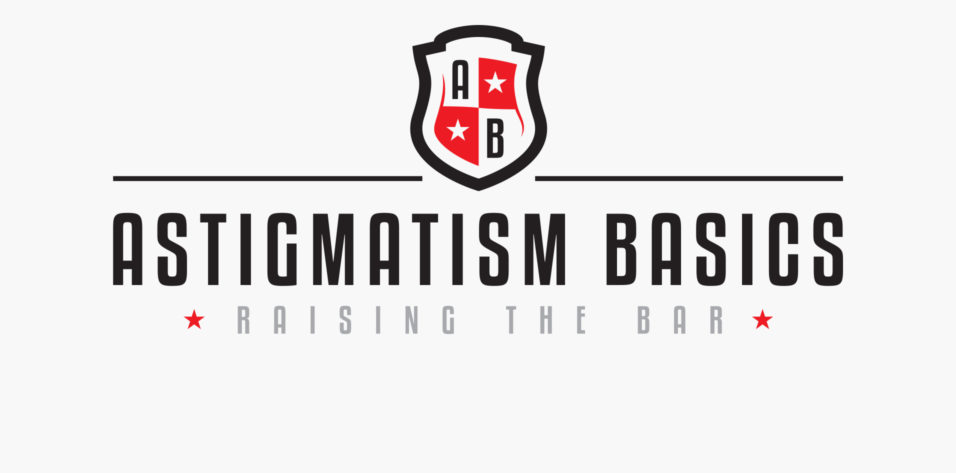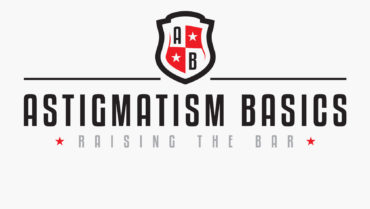Editorially independent content supported with advertising from

In patients undergoing cataract extraction with IOL implantation, astigmatism management is essential to provide the best visual outcomes possible. Uncorrected astigmatism leaves patients with blurry vision and a resultant decrease in contrast sensitivity.
Based on preexisting corneal astigmatism, approximately 50% of eyes would benefit from astigmatism correction at the time of cataract surgery.1 Taking into account the against-the-rule (ATR) drift that occurs with age, that number is even higher. Thus, it would be beneficial to manage astigmatism in a way that an eye with ATR cylinder could be converted to one with with-the-rule (WTR) cylinder. This could improve the patient’s uncorrected vision by reducing the absolute magnitude of astigmatism as well as delay the ATR drift by essentially resetting the clock. So, in my practice, the number of eyes that could benefit from astigmatism correction approaches 70%.
It is even more important for surgeons to address and control astigmatism when implanting a presbyopia-correcting IOL. Patients who select this option are paying a premium to achieve a better uncorrected range of vision, and they expect and deserve excellent results.
With the exception of the pseudo-accommodating Crystalens and its toric version, the Trulign (both Bausch + Lomb), all presbyopia-correcting IOLs available in the United States use diffractive optics. When uncorrected astigmatism is combined with diffractive optics, the resultant negative impact on vision is greater than with a monofocal IOL. Hence, these lenses are more sensitive to uncorrected astigmatism, and the importance of keeping astigmatism low is increased. In general, I prefer for these eyes to have no more than 0.50 D or less of uncorrected cylinder, as I find this results in the greatest outcomes and highest patient satisfaction. Again, I prefer for patients to have a small amount of WTR astigmatism.
EXPANDING OPTIONS
The first toric IOL available in the United States was the STAAR Toric plate-haptic silicone lens (STAAR Surgical). Unfortunately, this lens had a relatively high rate of rotation. The first single-piece acrylic toric IOL available in the United States was the AcrySof Toric (Alcon), which was approved in 2005, about 6 months after the ReStor +4.0 D multifocal IOL (Alcon).
The first multifocal toric IOL to receive FDA approval, the ReStor +3.0 D (Alcon), was not approved until 2015 and not available until 2016. This meant that relaxing incisions—limbal or eventually laser arcuate—were previously needed in many cases. These incisions are subject to differences in healing, potentially altering their effectiveness over time. Further, they are limited as to their magnitude of correction and are often less precise and accurate than toric IOLs. This, in turn, limited the number of candidates who were eligible for presbyopia correction using multifocal implants.
With the release of the ReStor +3.0 D toric and the subsequent approval and release of the Symfony Toric (Johnson & Johnson Vision) and ReStor +2.5 D Toric with ActiveFocus (Alcon), the number of candidates for presbyopia-correcting IOLs increased dramatically. Of course, the Trulign has been available the longest; however, this lens is sometimes limited and variable in its effect and possibly subject to Z syndrome,2-4 which may curtail its use. Although they utilize different optical designs, both the Symfony (an extended depth of focus lens) and the ReStor +2.5 D (a monofocal/multifocal hybrid) provide excellent quality of distance and intermediate vision (approximately 25 inches for Symfony and 21 inches for ReStor +2.5 D). Because they use diffractive optics, they both create night vision halos, although these are rarely significant in my experience.
Because we do not yet have access to an FDA-approved trifocal IOL (approval of the PanOptix [Alcon] is pending), surgeons must employ other alternatives for providing patients with a full range of vision. For patients receiving a presbyopia-correcting IOL (as opposed to monovision), my approach is as follows. First, I remind myself that I am treating one eye at a time—I don’t need to finalize my plan for the second eye until I see the how the patient fares after the first. I typically operate on the dominant eye first and most often implant the ReStor +2.5 D (or Symfony for patients who have larger pupils or need better intermediate vision beyond 22 inches). This approach provides exceptional quality of vision, especially for distance, and the lowest chance of night vision disturbance.
If the patient is happy all around or needs better intermediate vision, I implant the same type of lens used in the first eye and aim for emmetropia. For patients who desire better near vision, I typically implant the ReStor +3.0 D or Tecnis Multifocal (if a Symfony IOL implanted first). For those who are not good candidates for a true multifocal and/or have successfully used monovision, I implant the ReStor +2.5 D or Symfony and aim for -0.50 D. Again, if and when the PanOptix is approved (or another trifocal technology becomes available), I would implant this lens bilaterally, aiming for emmetropia in each eye.
SETTING THE STAGE
For patients receiving toric presbyopia-correcting IOLs, the same techniques and technologies used for monofocal toric IOLs are employed. I personally use the Lenstar (Haag-Streit), the OPD III (Nidek), and the Pentacam (Oculus). It is exceptionally important to optimize the ocular surface before performing measurements and surgery. I also like to see agreement between the various measurements and with the manifest refraction. If there is marked variability, I look closely for anterior basement changes. I have a low threshold for performing superficial keratectomy with subsequent healing before proceeding with cataract and lens replacement surgery.
Once I am comfortable proceeding to surgery, I take the final measurements, typically on a separate visit. I use the Barrett Toric calculator (or Barrett True K Toric for post–refractive-surgery eyes). This calculator uses the Barrett Universal II formula for the spherical component as well as a toric calculator, which takes into account the posterior cornea contribution and the effective toric lens power based on the lens power and effective lens position. My staff automatically runs the Barrett Toric for eyes with more than 1.00 D WTR and 0.50 D ATR. As stated previously, I prefer to leave the patient with less than 0.50 D WTR, and I have no concerns about flipping the axis from ATR to WTR to accomplish this. I use a centroid value of 0.12 for surgically induced astigmatism. I typically mark the patient in the preoperative area while he or she is sitting upright. I manually mark the 6 o’clock limbus first, followed by 3 o’clock and 9 o’clock. I have tried other devices and apps but found no improvement in outcomes.
OPTIMIZING SURGICAL OUTCOMES
In the OR, I mark the axis determined by the Barrett calculator using my preoperative marks as a reference. When implanting the lens, I fill the eye with a cohesive OVD. I ensure that all OVD is removed from underneath the lens and position the lens appropriately. In some cases, I like to use intraoperative aberrometry as a belt-and-suspenders approach. Most often, intraoperative aberrometry corroborates the Barrett calculation.
When implanting multifocal toric IOLs, I center the lens on the visual axis as best as possible. I do this by lining up the Purkinje images from the coaxial light on the operating microscope with the central ring of the lens as the patient is fixating on these lights. Often, this means that the toric marks on the lens may not line up directly with the pre-placed marks, but rather they may be parallel. Of course, this step is unnecessary if the Trulign lens is being implanted.
Although postoperative rotation of these lenses is rare, it can happen. If a rotation occurs, I typically advise waiting several weeks for the bag to contract before repositioning the lens, making rerotation less likely. In very long eyes, I will implant a capsular tension ring at the time of the second-eye surgery if I did not already insert one in the first eye. Some surgeons advocate for rotating a misaligned Symfony Toric at the slit lamp at the time the rotation is seen. I do not suggest doing this with the ReStor Toric, as these lenses are substantially stickier and damage to the capsule may ensue. If a rotation is needed (or an exchange if the power is off), I utilize the Barrett Rx formula available on the APACRS website. Alternatively, astigmatismfix.com can be used if only a toric IOL rotation is required.
Finally, it is not uncommon to encounter a patient with previous LASIK or RK who now has a cataract and wishes to achieve as much spectacle independence as possible. In the past, with older-generation multifocal IOLs, I would often implant the Crystalens or Trulign in patients with corneal astigmatism, as corneal aberrations did not mix well with the multifocal lens design. However, with the advent of the ReStor +2.5 D with ActiveFocus and the Symfony IOL, I now implant these lenses in these eyes quite frequently. I still look at the corneal aberration profile and the centration of the ablation, but I find that these lenses work extremely well in most instances.
CONCLUSION
With the high incidence of preexisting corneal astigmatism and the advent of IOLs that provide monofocal-like quality of vision and the ability to negate or minimize astigmatism, patients with cataracts and astigmatism have strong options for reducing their spectacle dependence. These options, as well as our outcomes, are likely to expand and improve in the future as lens technology continues to advance.
1. De Bernardo M, Zeppa L, Cennamo M, et al. Prevalence of corneal astigmatism before cataract surgery in Caucasian patients. Eur J Ophthalmol. 2014;24(40):494-500.
2. Ortega ARG, Higueras A, Ortiz-Gomariz A, et al. Correction of negative dysphotopsia in Crystalens Z Syndrome. J Emmetropia. 2013;4:101-104.
3. Yuen LH, Lee SY, Chua WH. Severe Z syndrome with the plate-haptic silicone hinged accommodating IOL. Paper presented at: 2010 ASCRS Annual Meeting; April 9-14, 2010; Boston.
4. Qi Y. Crystalens Toric IOL, Literature Review. Memorandum; Department of Health & Human Services. February 22, 2013. bit.ly/2YgbUbW. Accessed June 27, 2019.



